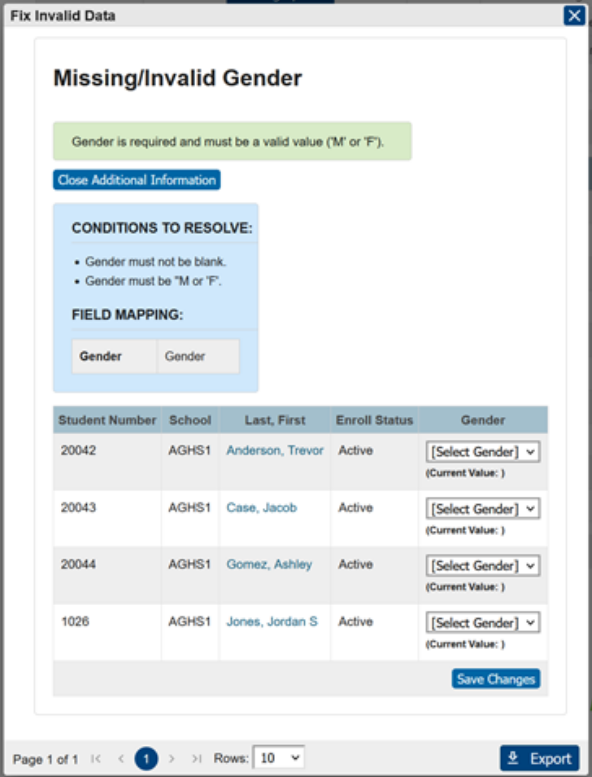When school districts need to locate the home addresses of all their students on a map, most still use primitive and labor-intensive methods adopted over decades.
New software created by Level Data allows for such location features to be mapped out in mere minutes. This feature can be utilized for future planning – but more importantly to identify very quickly which students are in-district between those who have slipped through the cracks and actually live out of the district, costing school districts the loss of precious government funding.
The first step for any PowerSchool SIS district is to establish full accuracy in address validation through Level Data’s State Data Validation Suite (SDVS), which allows registrars to input clean, accurate data the first time based on real-time flagging of errors or possible errors that can be corrected on the spot.
When it comes to home addresses, if there is an address in a school district’s system that doesn’t comply with the U.S. Post Office standards, it’s going to be flagged by Level Data’s software plug-in and district personnel will be notified that there is an issue that needs to be looked at more. (The same data-cleaning technology applies to all sorts of other student and staff data well beyond addresses, making for extremely clean State Data Funding submissions).
The Vail School District is on the border of Tucson, Arizona has been experiencing huge growth in recent decades. It went from one K-8 school with 400 students 35 years ago to today’s 15,000 kids and 21 buildings, with two more K-8s in progress. Before partnering with Level Data, it relied on one person who knew the area well to track all such open-enrollment students and their locations.
“We saw this as an opportunity to build a tool that would replace the labor-intensive job our former transportation secretary (who retired) carried around with her – and give us a lot more freedom in mapping, moving boundaries around, and seeing how many students we have in the various neighborhoods,” said Norm Purdy, Director of Student Data and Outreach.
So, this gives us a lot more flexibility in finding out where our students are located, who is open enrollment, are they marked ‘open enrollment’ appropriately – are they in our district or are they out of our district?
Purdy’s IT team member, Veronica Preciado, added: “The district has since changed so drastically in terms of the number of homes that have been built and the new neighborhoods, so we just knew that tracking it the way she used to track it was not going to be a viable solution.”
In SDVS, districts can see their boundary map, but until recently it was utilized using one student at a time validation. This new RealTime Report with the Mapping feature allows any PowerSchool user in the district to select student groups (by graduation year, age, socioeconomic, etc.), perhaps an entire school, and even realistically pick the entire school district – and in just seconds will show all of the students on a map to easily identify whether or not they live inside the district boundaries or fall outside those borders.
For Future Planning:
District boundaries are brought in automatically and plotted based on statistics from the U.S. Census Bureau.
A newly-created second overlay map in this RealTime Report allows districts to draw their own new boundaries, for example when doing any population shift mapping within the district footprint.
Districts can use the new feature to draw their individual school boundaries. If the population has shifted enough that one school is overcrowded and another has open space, they can instantly move map boundaries to see which students could be transferred, and know their grade level, their gender, their race, etc. to balance out various factors … all electronically.
For example, by just moving a school boundary two blocks down the street the user can instantly get feedback on how that shift will affect the end-use, whether by age, grade, or socioeconomic data, among other factors. This applies to district growth and expansion or making educated decisions for school closings.
If constructing new buildings like Vail School District is planning, this report can easily determine key factors for where to build it, based on students' addresses, but also track students’ grade level from the current day and into the future, all to determine the best distribution of students, teacher staffing needs, student planning, etc.
Vail’s new Director of Building and Facilities would frequently ask for student location data or rely on the previous data loaded into PowerSchool.
“But now he can just go in and play with it and he can manipulate the zones (in the map) that are best for his search. And he can do it himself,” said Vail’s Louise Miles. “He doesn’t have to wait for any secretary, or get us to try and get all the data pulled together…This new system is SO easy to use, he’s able to do it himself and can look at the filters and figure out what information he wants – so he’s been really thrilled with that.”
The main impetus is with a few clicks, piles of information can be gathered, and multiple options discovered in short amounts of time without starting over from square one.
“The whole point of this was to replace a very labor-intensive system, but there are so many more things this can do,” Purdy added.
Anyone who needs data, if they have access to PowerSchool, instead of submitting a request to have data gathered, they can get it themselves.





